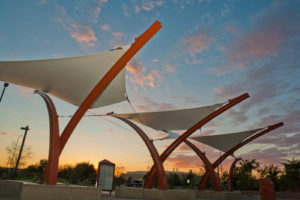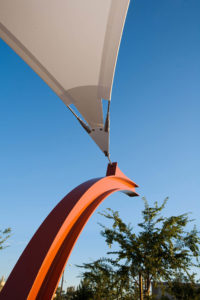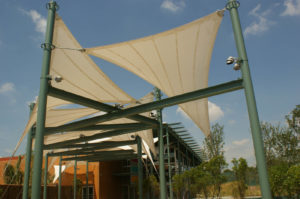
When it comes to specifying hardware for shade structures, fabricators and clients can rely on the wisdom of “sweating the details.”
“Ideally, the fabricator and architect should be working together from the schematic phase,” says Erik Jarvie, PE, sales engineer with Tension Structures, a division of Eide Industries Inc., Cerritos, Calif. “The knowledge of a fabricator can help an architect choose a design direction that fits the client’s budget. Also, the fabricator can help advise on appropriate paint finishes, cable types, and most importantly the best fabric for the application.”
Jarvie speaks from experience, having worked with clients and clients’ architects over several years as a staff structural engineer with Eide Industries. This is the kind of knowledge that can only be gained from actual project work, trial and error, and, as the saying goes “sweating the details.” There are numerous examples of beautiful projects marred by a wrinkle in the fabric or a skewed connection point that becomes a problem later down the road. It’s the equivalent of a tuxedoed bridegroom all dressed for the wedding, but arriving with a smeared or torn collar. Not acceptable.

The hard(ware) choices
Matching hardware with the appropriate fabric is the sort of detail that separates the experts from the also-rans. As Jarvie can tell you, almost any attachment type can be adapted to meet the properties of any fabric, but it might not always be prudent. “The engineering analysis should be monitored closely so that local stresses don’t cause a failure,” Jarvie says. “For example, a fabric with a fiberglass scrim may have excellent tensile strength, but may tear easily. It may not be wise to use grommets and lace rope on this type of fabric without reinforcements and testing.”
For Ryan Chism, estimator and project manager, The Chism Co., San Antonio, Texas, company experience leads to successful tried-and-true solutions. “We’ve developed some pretty hard-and-fast rules that we follow in how we build things, and in what connections we use for ease in installation and a more-or-less guaranteed fit. The more you have to wrestle with the fit and make adjustments, the more exposure there is to damaging the fabric or working unsafely.”
Details, details, details
“Almost every shade structure is unique and may require different types of hardware elements,” Jarvie says. “Some have ‘fixed’ fabric attachments to the frame, which eliminates the need for any cables. And there are several ways to attach fabric to a frame: awning rail, clamp bars, lace rope or adjustable aluminum extrusions. For cable perimeter shade structures, the hardware will vary depending on the size of the structure. Smaller structures may only require simple cables terminated with a thimble and cable clamps, then an anchor shackle attaches it to the frame while still allowing some articulation.”
Larger structures may require a membrane corner plate, adds Jarvie. “The membrane plate can be modified to terminate the catenary cables with some bit of adjustability. The membrane plate also can clamp the corner of the fabric. If some adjustability is desired, the membrane plate can attach to the frame with a couple of anchor shackles, or with a turnbuckle. Or if the frame is modified to receive a threaded clevis jaw end from the membrane plate, then that would serve to provide some adjustability as well.”
For even larger structures, according to Jarvie, where the loads of the cable may tear the fabric pocket open, “it is common to fix clamp bars around the perimeter of the fabric and use aluminum straps to attach the clamped fabric edge to the cable. The straps can be placed at 12-inches on center or something close to that depending on the engineer’s recommendations.”

Client relations
Both Jarvie and Chism agree that the best work is done when all key partners in the project—client, architect, fabricator—have regular and freely open communication during the life of the project.
“It is in the best interest of the client,” Jarvie says, “if the fabricator establishes a performance specification with minimum qualifications for the product and the manufacturer. This will ensure that even the ‘low bidder’ will still meet the expectations of the client.”
“In projects where there is a unique shape or size that is critical,” Chism says, “we see architects calling for meetings during the design phase so that they can get a sense of the steel members, pier sizes, and limitations that might apply to their design. Generally, in those meetings they are working toward a set of parameters that will keep the fabric structure within budget. In most cases, these meetings simply refine the concept into a design that can be made to match certain performance expectations.”
He adds: “Occasionally we do reach a point in the conversation where achieving all of the original expectations becomes impractical, and the firm needs to go back to the owner to clarify priorities: waterproof/non-waterproof, clear span, dynamic shapes or more functional, etc.”
As Craig G. Huntington, SE, F.ASCE, president of Huntington Design, states, “shade structures don’t necessarily require consulting by a structural engineer, but they need to be both conceived and detailed with a good understanding of their structural behavior. Sophisticated fabricators, working with architects, can fill in this gap, and the owner and architect should take this into consideration in choosing a fabricator.”
Bruce N. Wright, AIA, is a consultant to designers and architects and a frequent contributor to Fabric Architecture.
 TEXTILES.ORG
TEXTILES.ORG


